We are going to make a brief review of all its generations, focusing on the most outstanding features. For the time interval between generations we have based ourselves on the data provided by Ford.
Generation 1: 1976 to 1983
As we have analyzed, this was the first generation of the Fiesta, only with the three-door variant. It was manufactured in Almussafes, Dagenham (UK) and Cologne (Germany) and mounted the modified Kent engine, named Valencia, in honor of the Spanish factory. After the initial launch, the 1.3 engine was introduced with 66 hp, the S version. In 1981 some minor modifications were made, and the XR2 version was launched with 1.6 engine, with 84 hp and 801 kg. Two years later came the end of its production: in total seven years of life with more than two million units sold.
The versions and prices at the time were as follows:
| FORD Fiesta S | 350,407 pesetas | 14.169,10 € |
| FORD Fiesta Ghia 1300 | 419.205 pesetas | 16.950,99 € |
| FORD Fiesta Ghia | 390.767 pesetas | 15.801,11 € |
| FORD Fiesta S 1300 | 380.160 pesetas | 15.372,20 € |
| FORD Fiesta L | 322.893 pesetas | 13.056,56 € |
| FORD Fiesta | 297.569 pesetas | 12.032,56 € |
In the last column we have reflected the equivalent price it would have today, adjusting for inflation.
Generation 2: 1983 to 1989
It was time for a renewal of this bestseller, without touching too much not to end its success. That's why the design evolved without radical changes, with some very subtle changes in its design and chassis. The XR2 was also updated, now with 96 hp, giving it a sportier look and a 5-speed gearbox. This generation saw the introduction of an automatic gearbox called CTX for the first time, as well as the first diesel in a compact car: the 54 bhp 1.6 engine achieved 3.8 l/100 km, which was quite economical.
Generation 3: 1989 to 1996
The B-segment was in full swing at this time, and the Fiesta's design was beginning to show signs of age, so a major redesign was carried out, while retaining its original styling. For the first time a five-door option was added to the Fiesta range, which could be combined with 11 engines, one of them diesel. Perhaps the most notable and legendary is the Fiesta XR2i, with electronic injection and 110 hp power. It would be ousted in 1990 by the Fiesta RS Turbo, which mounted the same engine as its big brother, the Escort RS Turbo, with 133 hp, all combined with ABS brakes, made the Fiesta one of the most advanced compact of its time. Hot hatches were all the rage.
Generation 4: 1996 to 1999
In this generation the leap is smaller, producing some changes at the technical level, but mostly at the aesthetic level. It introduces the oval front grille, quite ungraceful, and a generally more rounded shapes. As for engines, a new generation is introduced with the Endura and Zetec, made of aluminium.
Generation 5: 1999 to 2001
Taking advantage of the arrival of the Focus, with a new styling language, the Fiesta's design was renewed. The oval grille was eliminated, and its headlights were stretched. Its equipment was increased and already offered traction control and dual airbags. To the existing factories, two more were added: São Bernardo do Campo in Brazil and Port Elizabeth in South Africa, adding the production of the 4-door version for emerging markets in Africa, Asia and Latin America.
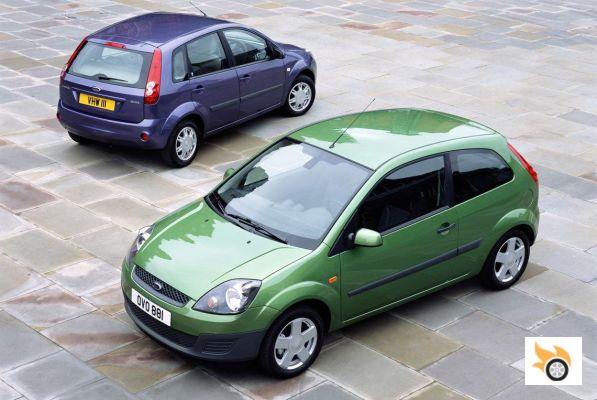
Generation 6: 2001 to 2008
25 years after its launch, it was time to rethink the Fiesta from head to toe in order to compete in a hotly contested segment. It started from a blank sheet of paper and was completely redesigned: exterior design, interior, suspension, engines, etc.. It now measures 3.918 m long, 1.685 m wide, 1.464 m high and has a wheelbase of 2.486 m: 9% more length and wheelbase and 11% wider and taller. Weight also increased to 1,096 kg.
The Forito was getting bigger. The engines also grew and were a 1.25-litre 75 bhp, a 1.3-litre 60 or 70 bhp, a 1.4-litre 80 bhp and a 1.6-litre 101 bhp. Meanwhile, the diesel engines are a 1.4-liter 68 hp and a 1.6-liter 90 hp, from the alliance with PSA. For its part, the Fiesta ST mounted a 2-liter 150 hp, with which he was able to reach 210 km / h. It was equipped with ABS, EBD and specific suspensions that made it the sportiest Fiesta to date.
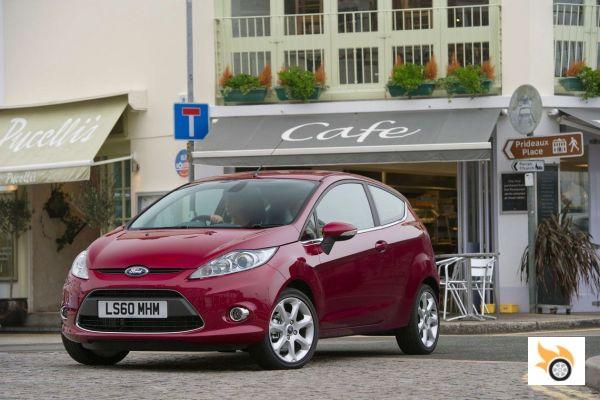
Generation 7: 2008 to 2012
In this new generation there is a further step in the modernization of the Fiesta, sharing the platform with the Mazda2. In terms of engines, three petrol engines are offered: a 1.2-litre 60 or 82 bhp, a 1.4-litre 97 bhp and a 1.6-litre 120 bhp; all of them are naturally aspirated and have indirect injection and inline four-cylinder engines. Meanwhile, the diesels are a 68 bhp 1.4-litre and a 90 bhp 1.6-litre, both with direct injection with common-rail fuel injection and turbocharging.
This generation was discontinued in Dagenham (UK), but instead is manufactured in more places in the world, such as Valencia (Venezuela), Nanjing (China), Cuatitlán Izcali and Hermosillo (Mexico) and Rayong (Thailand); apart from the historical plants of Cologne, which continues to manufacture it since 1976. This would be the last generation that would manufacture Almussafes, as from 2012 announced that abandoned the production of the party and went on to produce the C-Max.
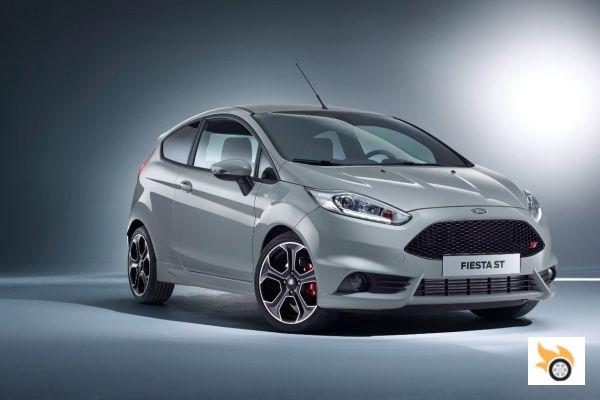
Generation 8: 2012 to... 2017?
In 2012 the Fiesta that we currently have on the market was presented. And that most likely has its successor in 2017, although it is not 100% confirmed. Ford's little car is once again inspired by its big brother, the Focus, from which it takes its styling cues. The equipment is very rich, incorporating LEDs as daytime running lights, the MyKey system, Ford SYNC in the multimedia section or automatic braking. Regarding its engines, downsizing returns, with the three-cylinder 1.0 EcoBoost petrol, in versions of 100, 125 and 140 hp power. The 1.25 litre 4-cylinder version was added later, with 82 bhp for the most basic trim levels.
On the diesel side, there are two 1.5 litre engines, with 75 and 95 bhp. We could not miss the sporty version, the Fiesta ST with its 1.6 l engine and 182 hp. It's a pity we don't have an RS version, like the Focus. It could have been a lot of fun, and it would have fit in with the new line Ford is taking in terms of sporty versions. Although to compensate, Ford launched this year the limited edition ST200, with 200 or 215 hp. You can see here Javier's test of the Ford Fiesta ST last summer.
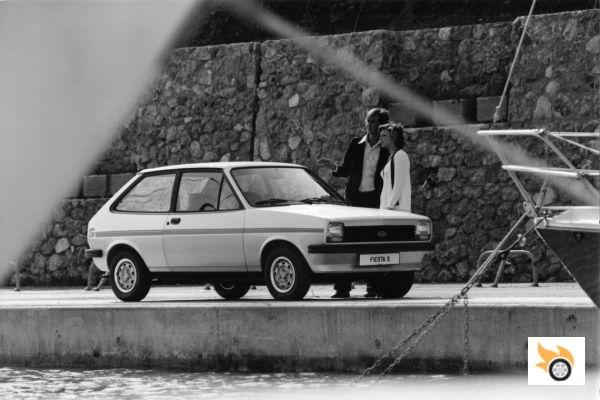
How we've changed...
In order to appreciate how the Fiesta has changed in 40 years, let's make a brief comparison between version 1 of 1976 and 2016.
| Generation 1 (1976) | Generation 8 (2016) |
| The 1976 Fiesta was only sold as a three-door, and was 3.565m long, 1.360m tall and 1.567m wide. | The current Fiesta is available in 3-door and 5-door (4-door in some markets). It is 404 mm longer, 135 mm taller and 155 mm wider. |
| The Ford Fiesta S, the sporty version, was priced at the equivalent of 14,169.10 euros. | The 140bhp ST-Line version is priced at €16,925, just €2,755 more, in exchange for more power, safety and equipment. |
| It had 45 hp and did 0-100 km/h in 17.6 seconds. Top speed was 137 km/h. | Leaving aside the ST, the Fiesta has 140 hp and does 0-100 km/h in 9 seconds, 8.6 seconds less. Top speed is 201 km/h |
| Although the measurement standard was slightly different to today's, the Fiesta was rated at 5.9 l/100 km at 90 km/h. | The 140 hp Fiesta is rated at 3.9 l/100 km on the current cycle. |
| Even back then, the Fiesta offered safety features such as a collapsible steering column and computer-aided chassis design. | Today's Fiesta offers ABS, ESP, 7 airbags and emergency braking, achieving 5 EuroNCAP stars. |
| Back then the interior was fairly simple, with a radio that switched on and off at the touch of a button and a clock on the centre console. | Today the multimedia section is covered by Ford SYNC, for making calls, voice commands, viewing the rear camera or having heated seats. |
Competition
The company has always been linked to racing, to offer that Fiesta connection to the sporting world. Let's take a brief look at some of the most important models dedicated to competition based on this model.
Ford Fiesta 1100 Gr. 5 (1978)
Perhaps an unknown, it seems that it was the first (unofficial) preparation for competition of a Ford Fiesta. It was made by Wolfram Steinert. He turned a Fiesta 1100 S into a 150 bhp (130 bhp/l) machine, accelerating in 6.2 seconds from 0-100 km/h, thanks to its low weight of 640 kg, and reaching 173.8 km/h.
Ford Fiesta Rally Car (1979)
In 1979 Ford decided to prepare a Fiesta to compete in the Gr. 2 Monte-Carlo Rally. It was the 1.6 l engine with twin carburetor, 155 hp power and 4-speed manual transmission. However, it weighed no more than 800 kg. With this it accelerated in 6.6 seconds from 0 to 100 km / h and reached 145 km / h top speed. It would finish in 10th position, with Ari Vatanen at the controls. The Lancia Stratos HF was first, and the Ford Escort RS 1800 was second. Still, quite an achievement for the Fiesta in its first official competition.
Ford Fiesta Challenge (1980)
To increase the visibility of the Fiesta, Ford creates in 1980 the Fiesta Challenge single-brand cup, where they compete with the 1.3 l model, suitably prepared for circuit. Today it survives alongside other cups in the British Racing and Sports Car Club (BRSCC) such as the Quaife Fiesta Championship.
Ford Fiesta RS WRC, S2000, RRC and R5
And now we come to the present day, where Ford collaborates with M-Sport to make their preparations. They make four models in different rally categories, such as the RS WRC for the top category. The S2000 competes in WRC 2, a sort of entry to the top category. The RRC is derived from the S2000 specification, to be adapted to different regional rallies. And finally the R5, which is based on the Fiesta ST to give it four-wheel drive and more power, to compete in the WRC championship, but at a much lower price. This preparation involves the disbursement of about 180,000 euros, much less than the 500,000 euros estimated cost of a WRC.
The lesser-known Ford Fiesta
Now we go with a few vehicles not well known, but that part of the base of the Ford Fiesta for its conception. Many of them didn't go beyond prototype, but at least as a curiosity, it's worth knowing them.
Ghia Corrida (1976)
Presented at the 1976 Turin Motor Show and based on the Fiesta platform, it continued the tradition of Spanish names. It was Ghia's vision of what a sports car should be like. It had "gull-wing" doors, a modular dashboard and headlight flaps to improve aerodynamics. Twenty years later, it would be the forerunner of the Puma, a sports car built on the Fiesta platform. And the flaps were the inspiration for the active grille that is fitted today.
Ghia Prima (1976)
Presented together with the Corrida, it was a two-seater, with interchangeable parts, which could make the car a pick-up.
Fiesta Fantasy (1978)
Very similar to the Prima, this was a pick-up based on the Fiesta, and made to commemorate Ford's 75th anniversary. This one did go into production, although with
Ghia Tuareg (1979)
A small SUV based on the Fiesta, made in collaboration with Ghia. Elevated suspension, protective bars, roof lights and special tires complete this concept that served to test what would be the SUV "fever" that we have today.
Ghia GTK (1979)
The Ghia GTK (Grand Touring Kombi) presented the concept of a small sports car with sharp lines. Equipped electric windows, trip computer, and digital dashboard, very advanced at that time.
Ghia Pockar (1980)
Playing with the mixture of the words pocket and car, they presented a prototype of a mini minivan based on the Fiesta. It was equipped with an exterior luggage compartment in the doors. This would be the precursor of the current B-Max.
Ghia Shuttler (1981)
Ghia introduced the Shuttler in 1981, a coupe 2 meters long, 1.5 m shorter than the Fiesta, which evokes the image of the Ford Sierra, but in miniature.
Ghia Barchetta (1983)
This time the people at Ghia took an XR2, a radial, and removed the roof, making a two-seater convertible. A design that didn't make it past prototype, but could have worked because of its great styling and originality.
Fiesta Urba (1989)
It seems that in this case, the Ford design team ran out of ideas, and what they did was to take a Fiesta 5 doors, and remove one on the passenger side. They did put parking sensors (very strange to see in that year) and a fridge in the trunk.
Fiesta Bebop (1990)
Ford returns to the inspiration in the Prima and Fantasy, making again a small pick up based on the Fiesta. It seems to insist on the concept, but did not reach production, as in the previous two cases.
Ghia Zig and Ghia Zag (1990)
The Zig was a two-seater convertible, with a very low windshield line; and the Zag was a small van. The study aimed to demonstrate the versatility of the same platform to make different models. Something that today is fundamental in the industry and that these models already anticipated.
Ghia Lynx Concept (1996)
Based on the 4th generation of the Fiesta, this is a convertible coupe, but keeping the arches that join the A, B and C pillar. A bit strange, but its design hid what would become the Ford Puma.
Ghia Saetta (1996)
Ghia continued with the radial, and this time they took a Ford Ka to remove the roof. In this case the roof had glass panels, like a targa. This time Ford did take it to production as StreetKa.
Ford Libre Concept (1998)
Change of disc in the radial, and for another prototype. This time the Ford Libre is a convertible that has interesting solutions: it has 4 seats, and the back seats are accessible through two doors with suicide opening.
Ford RallyeConcept (2002)
This prototype would advance the lines of a future Fiesta to compete in the S1600 class. It was based on the 1.6 engine but boosted to 200 hp, Hewland 6-speed sequential gearbox and racing suspension.
Ford Fiesta RS Concept (2004)
From my point of view, the most interesting concept based on the Fiesta, which could perfectly have gone into production. The most extreme street version, with widened wheel arches, 180 hp engine, stiffer chassis and sport suspension. With some updates, it could be the next step up from the current Fiesta ST.
Ford Verve Concept (2007)
A prototype very close to production, as it advanced the master lines of the Fiesta Gen.7. The most notable changes: trapezoidal grille and headlights torn, almost joining the A-pillar.
Ford B-Max Concept (2011)
At the 2011 Geneva Motor Show, the B-Max Concept was presented, based on the Fiesta Gen.7 platform, which would go into production with virtually no design tweaks. This mini minivan presented ingenious solutions, such as the elimination of the B-pillar and sliding rear doors, which gives great ease of access to the passenger compartment.
Fiesta ST Concept (2011)
Finally, we have the ST Concept, a vehicle that also went into production, and which previewed the sporty line of the production Fiesta ST, equipped with striking wheels, rear spoiler and red color, to extol its sporty aspirations.
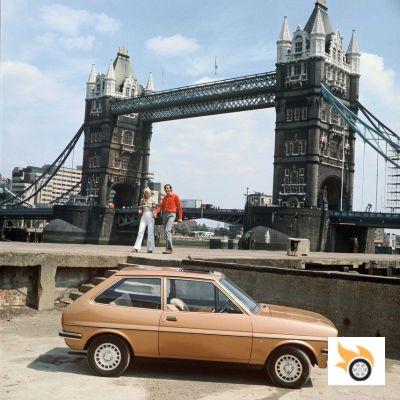
Timeline
And for the more curious, here's the Fiesta's timeline with its major milestones and milestones, from its conception to the present day.
1972
- Fiesta is conceived as the secret "Bobcat" project to create a new B-segment small car for the world, a mission closely followed by Ford Chairman Henry Ford II.
- Work begins in Europe and the United States to develop the new car, from its mechanical architecture and design elements to market positioning.
1973
- Oil crisis rocks the planet, adding urgency to Ford's goal of creating a small, practical, fuel-efficient car.
- Ford's Board of Directors gives the green light to produce what will be the new Fiesta, codenamed "Bobcat".
1974
- Construction begins on the 2.7 million square metre Valencia factory.
1975
- Engine production begins in Valencia
- Fiesta name was personally chosen by Henry Ford II because it evoked the celebration of Ford's new connection to Spain
1976
- The first production Fiesta rolls off the line in Saarlouis, Germany on May 11, 1976. More than 84,000 Fiestas are built in Saarlouis that year.
- Ford Chairman Henry Ford II and King Juan Carlos of Spain attend the inauguration of the new Valencia assembly plant on October 18, 1976, kicking off mass production of the Fiesta in Spain.
- Ghia unveils the first two Fiesta-based concept cars - the Corrida and Prima - at the Turin Motor Show in November 1976
1977
- Ford introduces a new larger displacement 1.3-litre petrol engine in the Fiesta including the new sporty S model and a Ghia version
- Fiesta production begins at Dagenham (UK)
- Export of Fiesta models for the U.S. market begins.
- Fiesta wins Car of the Year award in Spain
1978
- Fiesta wins British Design Council's Efficiency Award
- Ford prepares Fiesta to compete in Group 5 rallying.
1979
- Millions of Fiesta's are built to be sold worldwide. A specially prepared version competes in the Monte Carlo rally - this would become the inspiration for the Fiesta XR2.
- Former F1 champion Jackie Stewart announces Fabergé Fiesta Ladies race in London
1980
- Ford creates Fiesta Challenge, a competition to create a sporting connection with the Fiesta
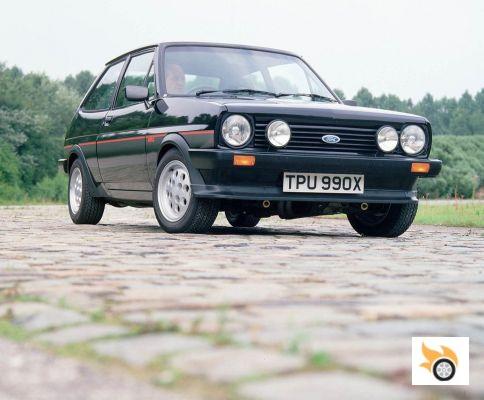
1981
- Ford introduces the new Fiesta XR2, with a 1.6-litre petrol engine, stiffer suspension, unique perforated alloy wheels and cosmetic tweaks, including extra headlights as an option. This was the first Fiesta to reach 100mph.
- Ford's Valencia plant builds the 1 millionth Fiesta
- Europe's 2 millionth Fiesta rolls off the Saarlouis line
- Ghia introduces the Shuttler concept based on Fiesta
1982
- Fiesta is the best-selling car for 6 years in a row in the UK and Germany
1983
- The new Fiesta Mk.II is introduced. This new model was larger and more fuel efficient, available with 1.0-litre and 1.1-litre petrol engines.
- The new 1.3-litre petrol engine was launched, linked to a five-speed gearbox.
- Ford introduces the 1.6-litre Fiesta diesel. This engine would become a mainstay of the Ford range for more than a decade.
1984
- A new version of the Fiesta XR2 is introduced with a 1.6-litre petrol engine, single overhead camshaft and five-speed gearbox, low-profile tyres and uprated suspension and brakes.
- Fiesta reaches 3 million units sold
- The first Fiesta runs on unleaded petrol
1985
- Ghia Urby concept car debuts, another Fiesta-inspired concept
1986
- Fiesta reaches 2 million produced in Valencia
- 1.4-litre lean-burn engine introduced
1987
- A CVT transmission called CTX is offered for the first time in Fiesta
- Fiesta is the best-selling car in the UK this year with 158,000 units sold
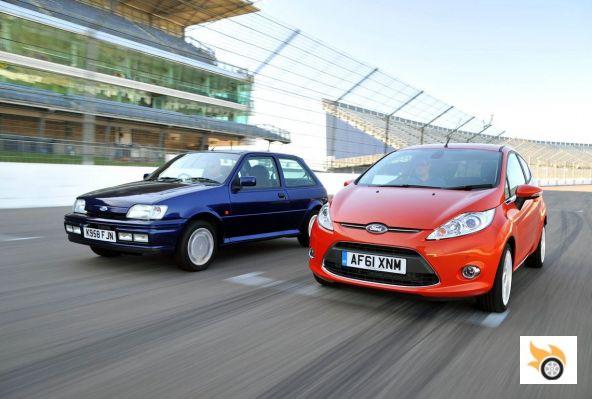
1989
- Ford launches Fiesta Mk.III with ABS brakes and lean-burn engines, in 1.0-litre and 1.1-litre petrol versions. The new Fiesta is longer, wider and has a longer wheelbase. It was available for the first time with three or five doors.
- Fiesta is the first small car in Europe with ABS
- In Cologne, the new Fiesta became a work of art depicted as the Goldener Vogel (golden bird) at the top of a museum tower in the city, the creation of artist H. A. Schult. The little car with the mighty eagle wings would become a favorite of the colonists and a popular sight for tourists.
- New LX trim level introduced, falling between the L and Fiesta Ghia trims
- 1.4-litre petrol engine - Ford's first engine to meet European emissions standards coming into force in 1996 - and 1.6-litre petrol engine added
- Fiesta XR2i joins the range this year with the new 1.6-litre twin overhead cam petrol engine and five-speed gearbox as the sporty compact of the range. The XR2i features widened wheel arches, body-coloured bumpers and new mouldings, plus version-specific suspension and tyres.
- Fiesta named Car of the Year 1989 by What Car? magazine.
1990
- Fiesta RS Turbo introduced at the Turin Motor Show. Using the XR2i engine with a Garrett turbocharger and intercooler, the Fiesta RS Turbo was 1.6 seconds faster than the XR2i in the 0-60mph.
1991
- Valencia celebrates the production of the 3 millionth Fiesta. The car is donated to the Queen Sofia Fund.
- Fiesta's best ever sales in Europe, with 624,186 sold
- Ford Fiesta Courier light van is introduced
1992
- The Fiesta RS 1800 is launched. Powered by a 1.8-litre 16-valve petrol engine with improved stability, plus five-spoke alloy wheels and a body-coloured spoiler.
ZETEC 1.8-litre 16-valve petrol engine introduced - Ford Fiesta is the official vehicle of Expo 92 in Seville
- Fiesta reaches all-time high of 648,781 European sales
1993
- Driver's airbag becomes standard equipment
1994
- Fiesta sells 548,046 units
1995
- 540,052 Fiesta and Fiesta Courier units are registered in Europe
1996
- Introduction of the new Fiesta Mk.IV with its new streamlined, aerodynamic shape and oval grille. Available with 1.25-litre, 1.4-litre and 1.6-litre petrol engines, plus a 1.8-litre diesel engine. Dual airbags as standard
- Fiesta celebrates another year of 600,000-plus sales
- Fiesta 4 million rolls off the Valencia assembly line
1997
- Ford Puma is launched, based on Fiesta architecture
1998
- Fiesta-based Libre concept introduced
1999
- Fiesta Mk.V and new Ford Fiesta Sport introduced worldwide at Frankfurt Motor Show
2000
- Fiesta gets 1.8-litre turbodiesel engine
2001
- New Fiesta Mk.VI unveiled at Frankfurt International Motor Show
- Production of new Ford Fiesta begins in Cologne and Valencia
2002
- All new Ford Fiesta is initially launched in five-door version, with new engine range, including new 1.3 or 1.6-litre 16-valve Duratec petrol with 16 valves
- Three-door Fiesta is launched, with new 1.4-litre Duratec petrol engine and a new 1.4-litre Duratorq TDCi common rail diesel engine
- Durashift EST automatic transmission introduced
- Ford RallyeConcept unveiled at Birmingham Motor Show
- New Ford Fiesta wins prestigious German Golden Steering Wheel award from Bild am Sonntag Sunday newspaper
2003
- Fiesta ST Cup introduced in German Touring Car Championship
2004
- Fiesta JWRC concept car unveiled at Geneva Motor Show
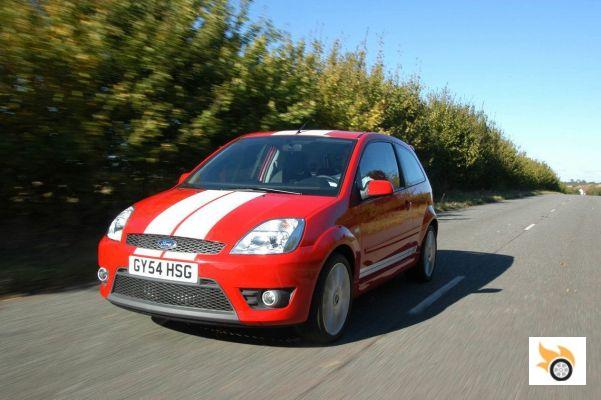
2005
- 150 PS Fiesta ST - the most powerful Fiesta to date - is launched as the first preparation for Ford Team RS
- Fiesta S is introduced
- Fiesta's best sales year since 1998, with 358,931 registrations across Europe
2006
- Voice activation and Bluetooth are introduced to Fiesta's specification
- Fiesta Sporting Trophy gets underway - a new single-make rally championship alongside the FIA World Rally Championship
2007
- Fiesta Zetec S 30th Anniversary Limited Edition Fiesta Zetec S launched in Radian Yellow and a chequered flag on the roof
- Ford Verve concept car debuts at Frankfurt Motor Show
2008
- All-new Fiesta Mk.VII unveiled at Geneva Motor Show
- Fiesta Mk.VII goes into production in Cologne, Germany; Valencia, Spain; and Nanjing, China, with new 1.6-litre Duratec Ti-VCT petrol and sub-100 g/km CO2 1.6-litre diesel engines
Fiesta ECOnetic is the UK's most efficient 5-seater family car with 3.7 l/100km and CO2 emissions of 98 g/km - Fiesta ST debuts with 2.0-litre Duratec petrol engine, delivering 150 PS and a top speed of 208 km/h (120 mph)
2009
- Fiesta makes its North American debut at the Los Angeles Auto Show
- Fiesta Kinetic Design styling wins Red Dot design award
- Named 'Car of the Year 2009' by UK magazine What Car?
2010
- Fiesta is Europe's best-selling car in the first quarter with 140,496 vehicles sold and 68,630 in March alone
- Fiesta's 1.6-litre Duratorq TDCi diesel engine boosts to 95 PS and three petrol engines benefit from CO2 emissions reductions
- Fiesta RS WRC unveiled at Paris Motor Show
2011
- Fiesta S 1600 special edition offers 134PS 1.6-litre Duratec Ti-VCT petrol engine
- Fiesta RS WRC makes competition debut with podium finish at Rally Sweden
- Fiesta Mk.VII reaches 1 millionth unit to roll off the production line in Cologne
- Fiesta celebrates 35th anniversary by achieving 15 million sales worldwide and benefits from interior and exterior upgrades
2012
- New Fiesta Mk.VIII goes on sale in Europe, with new technologies such as Active City Stop or MyKey, and seven engines with CO2 emissions below 100 g/km
- New Fiesta makes its North American debut at the Los Angeles Auto Show equipped with award-winning 1.0-litre EcoBoost petrol engine, certified as the most efficient non-hybrid car
- All-new Fiesta ST unveiled at Geneva Motor Show
- Fiesta is Europe's best-selling B-segment car of 2012, with one sale every two minutes
2013
- 182 PS Fiesta ST goes on sale. Ford receives nearly 10,000 orders in Europe in first 6 months, more than double forecast
- Fiesta named Supermini model of the year by UK magazine What Car?
- Ford Fiesta is Europe's best-selling car for the second year in a row with 293,663 cars
2014
- Ford debuts two-tone Fiesta Red and Black models. Equipped with a 140bhp 1.0-litre EcoBoost - the engine with the highest specific power output in production - delivering more power per litre than a Bugatti Veyron or Ferrari 458 Speciale
- In its first year of worldwide sales, Fiesta ST wins 22 industry awards
- More than half of competitors enter round seven of the FIA World Rally Championship in a Ford Fiesta, creating a new rallying world record
- Ford Fiesta is No. 1 in B-segment car sales in Europe for the third year in a row
2015
- New Fiesta R2 rally car is introduced at Geneva Motor Show, powered by Ford's 1.0-litre EcoBoost engine
- Three new colours are offered along with styling, equipment and comfort enhancements
New 1.5-litre TDCi diesel engine delivers 3.2 l/100 km and 82 g/km of CO2 - Black and White editions introduced
- Fiesta is Europe's best-selling B-segment car for the fourth year in a row
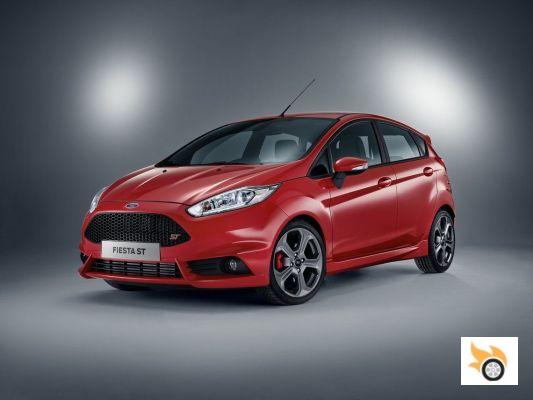
2016
- Ford unveils new 200bhp Fiesta ST200 at the Geneva Motor Show, with 6.7 seconds 0-100km/h. It's the most powerful Fiesta ever produced. Five-door ST also announced.
- Fiesta celebrates 40 years of production, with more than 17.6 million units sold worldwide.
Congratulations, Ford Fiesta.

























